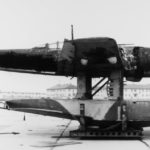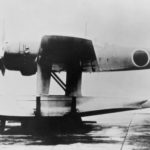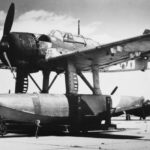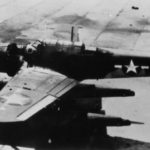Captured E16A1 3
E16A1 Zuiun “Paul” 634-16 of the 634th Kōkutai
E16A prototype
Captured E16A1 Zuiun
E16A1 Zuiun
E16A front view
The Zuiun (瑞雲) was a seaplane of the Imperial Japanese Navy produced by Aichi Aircraft. The aircraft’s abbreviation was E16A, and its Allied code name was “Paul”.
The IJN wanted to integrate the seaplane reconnaissance and bomber types in the 12-Shi Test Two-Seater Seaplane, and wanted it to be capable of dive bombing with 250 kg bombs (the possibility of integrating the seaplane observation (fighter/reconnaissance) and seaplane reconnaissance (bomber/reconnaissance) types was also discussed at the planning requirements deliberations). The IJN was outnumbered in terms of air power, and the idea was to overturn this disadvantage with a cruiser-based dive bomber. In February 1940, Aichi was instructed to produce a prototype, which had to have a maximum speed of at least 463 km/h, a maximum range of at least 2,500 km, good fighting performance and dive bombing capability. Based on these requirements, Aichi began development of the 14-Shi Test Two-Seater Seaplane Reconnaissance Aircraft (renamed the 16-Shi Test Seaplane Reconnaissance Aircraft in 1941), and completed the first prototype in March 1942. In March 1942, the first prototype was completed, and after a performance test in November of the same year, it was officially adopted as the Zuiun Type 11 in August 1943.
The fuselage was made of super duralumin, and the fuselage and wings were streamlined in order to achieve high performance, especially in terms of speed. The floats were the first seaplane in the world to be equipped with dive brakes for dive bombing, which were unique to the Zuiun in that a single plate at the rear of the float strut rotated nearly 90 degrees, rather than the double- or single-sided brakes seen on other models. The wings were equipped with air battle flaps, which was unusual not only for a seaplane but also for a dive bomber. Although many dive bombers were originally intended to be fighters to some extent, and were equipped with sights and machine guns for this purpose, the use of air combat flaps is rare. In the mass-production version, the aircraft’s structure was strengthened as well as its engines and armament. In addition, the dive brakes were modified with slit holes to prevent the aircraft from breaking up in mid-air during a dive. Aircraft was a masterpiece of seaplane, with better performance and attack power than any other aircraft of its time.
In the spring of 1944, the aircraft was assigned to units and was used for night bombing in the Philippines. Later, during the Battle of Okinawa, the aircraft was used for bombing and patrols, but by this time, as the war situation worsened, seaplanes such as this aircraft were rarely used. The aircraft deployed with the 634th Wing were trained on board the battleships Ise and Hyuga, which had been refitted with an aero-deck at the rear, but the 634th was transferred to the Philippines before the two ships could be put into action, so it was unable to take part in actual combat as an aero-battleship-mounted aircraft. However, the 634th was later engaged in reconnaissance, night raids and raiding missions in the Philippines and Okinawa, and was one of the few examples of a conventional attack that did not result in a suicide attack. The number of survivors of the Zuiun Corps heading for the Philippines was 9 out of 68. Total number of aircraft produced was about 220. Most of them were Type 11s, but a prototype Type 12 with a Kinsei 62 engine was built in 1945. There are no surviving models.





